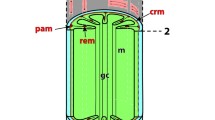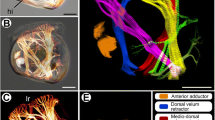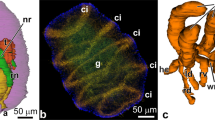Abstract
We studied the body-wall musculature, its ECM (extracellular matrix), and the junctional complexes between muscle cells and between muscle cells and ECM in Macrostomum hystricinum marinum Rieger, 1977, using Nomarski-contrast and electron microscopy. Differentiation of these body-wall components was followed by monitoring embryonic stages at 52%, 64%, and 82% of the time between egg-laying and hatching and with study of the hatchling and adult stages. For comparison, the body-wall musculature of other macrostomidans has been examined in conventional light-histological sections.
Muscles form a grid of longitudinally, diagonally, and circularly oriented fibers beneath the epidermis in M. hystricinum marinum and this orientation of cells can be found already in embryos at 64% development. Younger embryos at 52% development show no muscle differentiation. The ECM forms a net-like arrangement that apparently envelops the individual muscle cells. Characteristic knob-like thickenings of the ECM occur at the base of the epidermis. Muscle cells attach to each other, to the epidermis, and to other cell types through hemidesmosome-like junctions at thickenings of the ECM in the adult and hatchling stages; no true desmosomes exist between muscle cells. Gap junctions occur commonly between longitudinal muscles of adult specimens and between perikarya of muscle cells in embryos at 64% and 82% development.
More comparative studies are needed to determine the systematic value of presence or absence of the diagonal muscle fibers in the body wall of turbellarians.
Similar content being viewed by others
References
Ax, P., 1987. The phylogenetic system. The systematization of organisms on the basis of their phylogenesis. John Wiley & Sons, New York.
Ax, P. & W. Armonies, 1987. Amphiatlantic identities in the composition of the boreal brackish water community of Plathelminthes. Microfauna Marina 3: 7–80.
Chien, P. & H. Koopowitz, 1972. The ultrastructure of neuromuscular systems in Notoplana acticola, a free-living polyclad flatworm. Z. Zellforsch. mikrosk. Anat. 133: 277–288.
Clark, R. B., 1964. Dynamics in metazoan evolution. The origin of the coelom and segments. Clarendon Press Oxford, 313 pp.
Crezée, M., 1975. Monograph of the Solenophilomorphidae (Turbellaria: Acoela). Int. Rev. ges. Hydrobiol. 60: 769–845.
Doe, D. A., 1981. Comparative ultrastructure of the pharynx simplex in Turbellaria. Zoomorphology 101: 39–59.
Eisenman, E. A. & M. Alfert, 1982. A new fixation procedure for preserving the ultrastructure of marine invertebrate tissue. J. Microsc. (Oxford) 125: 117–120.
Gehlen, M., 1988. Morphologische und populationsdynamische Untersuchungen an experimentellen und natürlichen Populationen des M. hystricinum Artenkreises (Turbellaria, Macrostomida). Diplomarbeit an der naturwissenschaftlichen Fakultät der Universität Innsbruck. 98 pp.
Jellies, J. & W. B. Kristan, Jr., 1988. Embryonic assembly of a complex muscle is directed by a single identified cell in the medicinal leech. J. Neurosci. 8: 3317–3326.
Koecke, U., 1982. Allgemeine Zoologie 1. Bau und Funktion tierischer Organismen. Vieweg Studium 40, Friedrich Vieweg & Sohn, Wiesbaden: 211–244.
Luther, A., 1904. Die Eumesostominen. Z. wiss. Zool. 77: 1–273.
Luther, A., 1905. Zur Kenntnis der Gattung Macrostoma. Festschr. Palmen 5: 1–61.
Marcus, E., 1945. Sôbre Catenulida Brasileiros. Bol. Fac. Filos. Ciênc. Letr. Sao Paulo Zool. 10: 3–133.
Papi, F., 1951. Ricerche sui Turbellaria Macrostomidae. Arch. Zool. ital. 36: 289–340.
Pedersen, K. J., 1983. Fine structural observations on the turbellarians Stenostomum sp. and Microstomum lineare with special reference to extracellular matrix and connective tissue systems. Acta Zool. (Stockh.) 64: 177–190.
Rieger, R. M., 1971. Die Familie Dolichomacrostomidae nov. fam. (Turbellaria — Macrostomida). II Teil. Dolichomacrostominae Rieger. Zool. Jahrb. Abt. Syst. Ökol. Geogr. Tiere 98: 569–703.
Rieger, R. M., 1977. The relationship of character variability and morphological complexity in copulatory structures of Turbellaria-Macrostomida and Haplopharyngida. Mikrofauna Meeresboden 61: 197–216.
Rieger, R. M., 1981. Morphology of the Turbellaria at the ultrastructural level. Hydrobiologia 84: 213–229.
Rieger, R. M., M. Gehlen, G. Haszprunar, M. Homlund, A. Legniti, W. Salvenmoser & S. Tyler, 1988. Laboratory cultures of marine Macrostomida (Turbellaria). Fortschr. Zool. 36: 523.
Rieger, R. M., G. Haszprunar & P. Schuchert, 1991. On the origin of the Bilateria: traditional views and recent alternative concepts. In S. Conway Morris & Simonetta (eds), On the early evolution of the Metazoa and the significance of problematic taxa. University of Camerino Press (in press).
Rieger, R. M., S. Tyler, J. P. S. Smith, III & G. Rieger, 1991. Turbellaria. In F. W. Harrison (ed.), Microanatomy of the invertebrates, Vol. III. Wiley-Liss, New York.
Riser, N. W., 1987. Nemertinoides elongatus gen. n. sp. n. (Turbellaria: Nemertodermatida) from coarse sand beaches of the western North Atlantic. Proc. helminthol. Soc. Wash. 54: 60–67.
Robards, A. W. & U. B. Sleytr, 1985. Low temperature methods in biological electron microscopy. Vol. 10 in A. M. Glauert (ed.), Practical methods in electron microscopy. Elsevier Biomedical Press, Amsterdam.
Sterrer, W. & R. M. Rieger, 1974. Retronectidae — a new cosmopolitan marine family of Catenulida (Turbellaria). In N. W. Riser & M. P. Morse (eds), Biology of the Turbellaria. McGraw Hill, New York: 63–92.
Tyler, S., 1981. Development of cilia in embryos of the turbellarian macrostomum. Hydrobiologia 84: 231–239.
Tyler, S., 1984. Turbellarian platyhelminths. In J. Bereiter-Hahn, A. G. Maltoltsy & K. S. Richards (eds), Biology of the integument. Springer Verlag, Berlin: 112–131.
Westblad, E., 1937. Die Turbellarien-Gattung Nemertoderma Steinböck. Acta Soc. Fauna Flora fenn. 60: 45–89.
Westblad, E., 1949. On Meara stichopi (Bock) Westblad, a new representative of Turbellaria Archoophora. Ark. Zool. Ser 2 1: 43–57.
Westblad, E., 1953. Marine Macrostomida (Turbellaria) from Scandinavia and England. Ark. Zool. (2) 4 (23): 391–408.
Wood, R.L. & M. J. Cavey, 1981. Ultrastructure of the coelomic lining in the podium of the starfish Stylasterias forreri. Cell Tissue Res. 218: 449–473.
Young, J. O., 1976. Systematic studies on limnic Macrostomum species (Turbellaria, Macrostomida) from East Africa. Zool. Scr. 5: 49–60.
Author information
Authors and Affiliations
Rights and permissions
About this article
Cite this article
Rieger, R., Salvenmoser, W., Legniti, A. et al. Organization and differentiation of the body-wall musculature in Macrostomum (Turbellaria, Macrostomidae). Hydrobiologia 227, 119–129 (1991). https://doi.org/10.1007/BF00027591
Issue Date:
DOI: https://doi.org/10.1007/BF00027591




